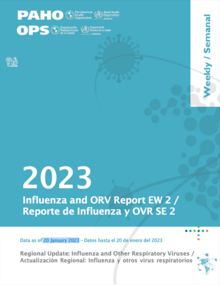North America: Influenza activity was low and continues to decline in the subregion. Influenza A(H3N2) predominated with the co-circulation of A(H1N1)pdm09 and B/Victoria. The SARS-CoV-2 activity was elevated, while RSV activity decreases with country and subregional differences. In Canada, influenza activity has decreased; surveillance indicators continued within expected levels. In Mexico, influenza activity was above expected levels, with low severity indicators. In the United States, influenza activity declined at low-intensity levels, with the percentage of deaths due to pneumonia, influenza, and COVID-19 above the average of previous seasons. RSV activity continued decreasing.
Caribbean: Influenza activity continued moderate in the subregion with B/Victoria virus predominance, with A(H1N1)pdm09 and A(H3N2) cocirculation. Influenza activity was elevated in Belize and the French Territories. The SARS-CoV-2 activity was moderate overall, while RSV activity was at baseline levels.
Central America: Influenza activity was moderate, with influenza A and B virus detections and B/Victoria predominance. Influenza activity was elevated in Guatemala, with influenza B/Victoria predominance. Overall, SARS-CoV-2 percent positivity decreased in the subregion; increased percent positivity was reported in Honduras and Panama. RSV activity remained raised in Guatemala and Panama.
Andean: Influenza activity was low, with the predominance of influenza B/Victoria and co-circulation of influenza A(H3N2) and A(H1N1)pdm09. Influenza activity was elevated in Bolivia, with increased SARI activity at moderate-intensity levels. In Ecuador, SARS-CoV-2 was elevated but decreasing. In the subregion, RSV activity was low overall.
Brazil and Southern Cone: Influenza activity was low, with all seasonal subtypes detected. The SARS-CoV-2 activity was elevated across the subregion but with a decreasing trend in some countries. Increased RSV activity continued to be reported in Brazil and Chile.
Global: Influenza activity remained elevated due to activity in the northern hemisphere. Where subtyped, influenza A viruses predominated, with a slightly larger proportion of A(H3N2) viruses detected among the subtyped influenza A viruses. In Europe, overall influenza activity continued to increase, with influenza positivity from sentinel sites remaining above the epidemic threshold at the regional level. Influenza A viruses predominated with A(H3N2) viruses accounting for most subtyped influenza viruses from sentinel sites but with regional differences. Half of reporting countries signaled high or very high intensity. In central Asia, influenza activity increased with influenza A(H1N1)pdm09 viruses predominant, followed by influenza B viruses. In Northern Africa, influenza detections increased among reporting countries with all seasonal subtypes detected. In Western Asia, influenza activity decreased overall with all seasonal influenza subtypes detected, though increased activity was reported in some countries in the transmission zone. In East Asia, influenza activity of predominantly influenza A(H3N2) viruses remained low overall among reporting countries but with increases reported in Mongolia and the Republic of Korea. In tropical Africa, influenza activity remained low, with detections of all seasonal influenza subtypes reported. However, activity increased in some countries in Eastern Africa. In Southern Asia, influenza activity remained low, mainly due to decreased activity reported in Iran (Islamic Republic of). Influenza A(H1N1)pdm09 was the most frequently detected subtype in the subregion. In South-East Asia, detections of predominantly influenza B remained elevated due to continued detections reported in Malaysia.
SARS-CoV-2 positivity from sentinel surveillance decreased globally, notably in the WHO Region of the Americas, from over 30% to just above 20%. In the Western Pacific Region, positivity decreased slightly and remained around 20%. Activity remained under 10% in the other regions. SARS-CoV-2 positivity from non-sentinel surveillance decreased significantly in the Region of the Americas and the Western Pacific region to approximately 20% and 10%, respectively, but increased in the African region to 15%.
|

